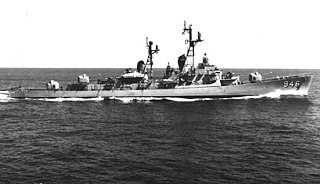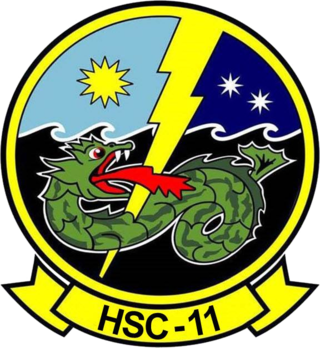
USS Lexington (CV/CVA/CVS/CVT/AVT-16) is an Essex-class aircraft carrier built during World War II for the United States Navy. Originally intended to be named Cabot, the new aircraft carrier was renamed while under construction to commemorate the recently-lost USS Lexington (CV-2), becoming the sixth U.S. Navy ship to bear the name in honor of the Battle of Lexington.

USS Bon Homme Richard (CV/CVA-31) was the 14th of the 24 Essex-class aircraft carriers completed during or shortly after World War II for the United States Navy. She was the second US Navy ship to bear the name, the first one being named for John Paul Jones's famous Revolutionary War frigate by the same name. Jones had named that ship, usually rendered in more correct French as Bonhomme Richard, to honor Founding Father Benjamin Franklin, the American Commissioner at Paris, whose Poor Richard's Almanack had been published in France under the title Les Maximes du Bonhomme Richard.
USS Intrepid may refer to the following ships of the United States Navy:

USS Intrepid (CV/CVA/CVS-11), also known as The Fighting "I", is one of 24 Essex-class aircraft carriers built during World War II for the United States Navy. She is the fourth US Navy ship to bear the name. Commissioned in August 1943, Intrepid participated in several campaigns in the Pacific Theater of Operations, including the Battle of Leyte Gulf.

The fifth USS Independence (CV/CVA-62) was an aircraft carrier of the United States Navy. She was the fourth and final member of the Forrestal class of conventionally powered supercarriers. She entered service in 1959, with much of her early years spent in the Mediterranean Fleet.

USS Edson (DD-946) is a Forrest Sherman-class destroyer, formerly of the United States Navy, built by Bath Iron Works in Maine in 1958. Her home port was Long Beach, California and she initially served in the Western Pacific/Far East, operating particularly in the Taiwan Strait and off the coast of Vietnam. Her exceptionally meritorious service in 1964 in the Gulf of Tonkin was recognized with the first of three Navy Unit Commendations. During the following years she was shelled by North Vietnamese land forces, and apparently received friendly fire from the US Air Force.

HMS Intrepid (L11) was one of two Fearless-class amphibious warfare ships of the Royal Navy. A landing platform dock (LPD), she served from 1967 until 1999. Based in HM Naval Base, Devonport, Plymouth, Devon and HM Naval Base Portsmouth, she saw service around the world over her 32-year life.

USS San Diego (AFS-6) was a Mars-class combat stores ship acquired by the U.S. Navy in 1968. She served the U.S. Atlantic Fleet until decommissioned in 1993. She then was redesignated as a United States Naval Ship, assigned to the Military Sealift Command, and served in a non-commissioned status with a mostly civilian crew as USNS San Diego (T-AFS-6) until 1997.

Aircraft carriers have their origins during the days of World War I. The earliest experiments consisted of fitting temporary "flying off" platforms to the gun turrets of the warships of several nations, notably the United States and the United Kingdom. The first ship to be modified with a permanent flight deck was the battlecruiser HMS Furious, which initially had a single flying-off deck forward of the original superstructure. Subsequently, she was modified with a separate "landing on" deck aft and later with a full flush deck. Other ships, often liners, were modified to have full flush flight decks, HMS Argus being the first to have such modification begun. Those first faltering steps gave little indication of just how important the aircraft carrier was to prove to be. During the inter-war years, Japan, the United Kingdom and the United States built up significant carrier fleets so that by the beginning of World War II, they had 18 carriers between them. The 1940 Battle of Taranto and 1941 Attack on Pearl Harbor in retrospect showed the world that the aircraft carrier was to be the most important ship in the modern fleet. Today, aircraft carriers are the capital ships of the navies they serve in, and in the case of modern US "supercarriers", they embark an air group that is effectively a small air force.

Helicopter Sea Combat Squadron 11 (HSC-11), also known as the Dragonslayers, is a United States Navy helicopter squadron based at Naval Air Station Norfolk as part of Carrier Air Wing 1 operating MH-60S helicopters deployed aboard aircraft carriers. The squadron was established on 27 June 1957 at Naval Air Station Quonset Point as Helicopter Anti-Submarine Squadron 11 (HS-11) with Sikorsky HSS-1 Seabat helicopters. In 2016, HS-11 transitioned to MH-60S and re-designated as HSC-11.

USS Webster (ARV-2) was a Chourre-class aircraft repair ship aircraft repair ship that saw service in the United States Navy during World War II.

The Essex class was a class of aircraft carriers of the United States Navy. The 20th century's most numerous class of capital ship, the class consisted of 24 vessels, which came in "short-hull" and "long-hull" versions. Thirty-two ships were ordered, but as World War II wound down, six were canceled before construction, and two were canceled after construction had begun. Fourteen saw combat during World War II. None were lost to enemy action, though several sustained crippling damage. Essex-class carriers were the backbone of the U.S. Navy from mid-1943 and, with the three Midway-class carriers added just after the war, continued to be the heart of U.S. naval strength until supercarriers joined the fleet in the 1950s, 1960s and 1970s. Several of the carriers were rebuilt to handle heavier and faster aircraft of the early jet age, and some served until well after the Vietnam War.
This page is based on this
Wikipedia article Text is available under the
CC BY-SA 4.0 license; additional terms may apply.
Images, videos and audio are available under their respective licenses.










